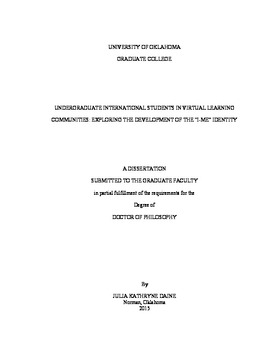| dc.contributor.advisor | Smith, Joan | |
| dc.contributor.advisor | Ge, Xun | |
| dc.contributor.author | Daine, Julia | |
| dc.date.accessioned | 2015-08-14T13:37:14Z | |
| dc.date.available | 2015-08-14T13:37:14Z | |
| dc.date.issued | 2015-08 | |
| dc.identifier.uri | https://hdl.handle.net/11244/15504 | |
| dc.description.abstract | This qualitative study explored the experiences of twelve international students from different cultural and linguistic backgrounds in virtual learning communities in university and college courses. Specifically, this study explored how the students’ identity in virtual learning communities was influenced by interaction within the virtual community. The research questions for this study were: (1) What are international students’ experiences participating in virtual learning communities; and (2) How do international students’ experiences in a virtual learning community influence their development of identity?
The findings revealed four themes concerning the “I” and the “Me” within the students’ experiences with the virtual learning community. The first theme pertained to the ethnic “I” identity concerning how students viewed themselves. The second theme included the ethnic “Me” identity as it includes students’ perception of how others view them. Theme three dealt with the virtual ethnic “Me” identity that consisted of the student’s perception of how virtual peers view them. The fourth theme related to the virtual ethnic “I” identity that depicted how students see themselves online in the virtual learning community.
Three subthemes emerged from the findings. Together these subthemes influenced the virtual ethnic identity for international students. The identity sub-themes included the structure of the virtual learning community, challenges encountered in the virtual learning community, and change. Ultimately, the virtual ethnic” I” identity and virtual ethnic “Me” identity form the international students’ virtual ethnic identity.
Through the interpretive framework of symbolic interactions, the research data was analyzed through the lenses of social presence, identity development, and acculturation. The analysis focused on four virtual barriers to identity development in the virtual learning communities. These virtual barriers included 1) virtual social barriers, 2) virtual cultural barriers 3) virtual learning tools barriers, and 4) virtual dialogue barriers.
Further analysis of students’ experiences revealed virtual acculturation stressors when social and dialogue barriers were present. The stressors involved virtual dialogue stressors and virtual safety stressors. With meaningful interactions virtual stressors for international students were reduced. In summary, through the use of multiple theories, insight was gained into how students’ identity development and acculturation experiences were impacted by community members as well as barriers and stressors experienced in virtual learning communities. | en_US |
| dc.language | en_US | en_US |
| dc.subject | Virtual Learning Communities | en_US |
| dc.subject | International Students | en_US |
| dc.subject | Identity Development | en_US |
| dc.title | Undergraduate International Students in Virtual Learning Communities: Exploring the Development of the "I-Me" Identity | en_US |
| dc.contributor.committeeMember | Vaughn, Courtney | |
| dc.contributor.committeeMember | Crowson, Howard | |
| dc.contributor.committeeMember | Maiden, Jeffrey | |
| dc.date.manuscript | 2015 | |
| dc.thesis.degree | Ph.D. | en_US |
| ou.group | Jeannine Rainbolt College of Education::Department of Educational Leadership and Policy Studies | en_US |
| shareok.nativefileaccess | restricted | en_US |
